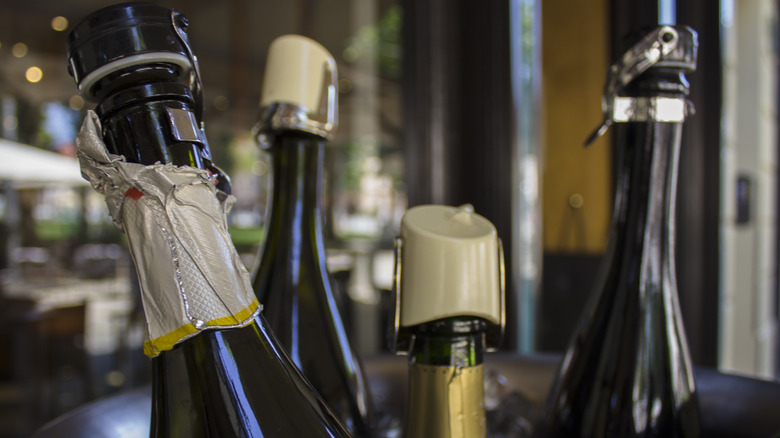Will A Raisin Really Save Your Flat Champagne?
If you've ever popped open a bottle of sparkling wine and didn't have the chance to finish it, you might be wondering if the trick of dropping a raisin in the bottle will bring the bubbles back the next day. Sadly, we're here to tell you no — this notion is based on a misunderstanding of the science behind carbonation. Although a raisin can make some fizz appear briefly, the trick will actually make the wine flatter in the end by releasing those bubbles as the raisin rises to the top of the glass.
You've probably seen videos of a raisin rising and falling with fine bubbles attached in a glass of flat Champagne, resulting in a poured glass that looks fizzy — and as much as we wish that was all it takes to produce sparkle, it's simply not. The idea behind this unconventional method is that the sugar on the raisin attracts dissolved CO₂, bringing the bubbles back to life. While it is true that the grooves on the raisin provide the gas a place to gather and be seen, any resulting fizz is short-lived because the raisin causes the bubbles to leave the wine.
In a test by America's Test Kitchen, a group couldn't tell the difference between fizz that had been opened for four days that had had the raisin treatment and another bottle open for the same period that hadn't. Once the carbon dioxide has gone it can't be replaced.
Preserve bubbles the right way
Champagne gets its effervescence from the carbon dioxide produced during the wine-making process. The carbon dioxide dissolves in the wine, creating those delightful bubbles. The bubbles get released when the cork is popped, but also when the gas finds a little place to make a bubble, like a tiny imperfection in a Champagne glass or on the skin of a raisin, and a small stream of fizz appears. Eventually, in contact with air, all the gas leaves the wine, and you have a flat bottle. And, raisin or no raisin, yesterday's bottle of fizz won't taste as good or as fizzy as when it was first opened.
In reality, the best way to not have flat Champagne is to prevent all those bubbles from leaving in the first place. Resealing the bottle tightly with a strong sparkling-wine stopper and refrigerating it can help slow down the escape of carbon dioxide and preserve the wine's effervescence for a longer period. While the raisin trick may be a charming anecdote, it remains debunked and an ineffective way to restore the sparkle to a bottle of Champagne.

